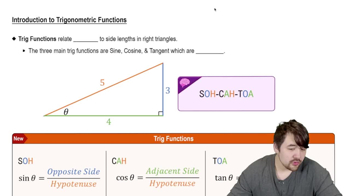Table of contents
- 0. Functions7h 52m
- Introduction to Functions16m
- Piecewise Functions10m
- Properties of Functions9m
- Common Functions1h 8m
- Transformations5m
- Combining Functions27m
- Exponent rules32m
- Exponential Functions28m
- Logarithmic Functions24m
- Properties of Logarithms34m
- Exponential & Logarithmic Equations35m
- Introduction to Trigonometric Functions38m
- Graphs of Trigonometric Functions44m
- Trigonometric Identities47m
- Inverse Trigonometric Functions48m
- 1. Limits and Continuity2h 2m
- 2. Intro to Derivatives1h 33m
- 3. Techniques of Differentiation3h 18m
- 4. Applications of Derivatives2h 38m
- 5. Graphical Applications of Derivatives6h 2m
- 6. Derivatives of Inverse, Exponential, & Logarithmic Functions2h 37m
- 7. Antiderivatives & Indefinite Integrals1h 26m
- 8. Definite Integrals4h 44m
- 9. Graphical Applications of Integrals2h 27m
- 10. Physics Applications of Integrals 2h 22m
1. Limits and Continuity
Finding Limits Algebraically
Problem 3.5.11
Textbook Question
Use Theorem 3.10 to evaluate the following limits.
lim x🠂0 (sin 3x) / x
 Verified step by step guidance
Verified step by step guidance1
Theorem 3.10 refers to the limit property: lim x→0 (sin x) / x = 1. This theorem is useful for evaluating limits involving sine functions as x approaches 0.
To apply Theorem 3.10 to the given limit, we need to manipulate the expression lim x→0 (sin 3x) / x to match the form of the theorem.
Notice that the argument of the sine function is 3x, not x. To use the theorem, we can rewrite the limit as lim x→0 (sin 3x) / (3x) * 3.
This manipulation allows us to separate the constant factor 3 from the limit expression, resulting in 3 * lim x→0 (sin 3x) / (3x).
Now, apply Theorem 3.10 to the expression lim x→0 (sin 3x) / (3x), which equals 1. Therefore, the limit becomes 3 * 1.
 Verified video answer for a similar problem:
Verified video answer for a similar problem:This video solution was recommended by our tutors as helpful for the problem above
Video duration:
5mPlay a video:
Was this helpful?
Key Concepts
Here are the essential concepts you must grasp in order to answer the question correctly.
Theorem 3.10 (Squeeze Theorem)
Theorem 3.10, often referred to as the Squeeze Theorem, states that if a function is squeezed between two other functions that converge to the same limit at a point, then the squeezed function must also converge to that limit. This theorem is particularly useful for evaluating limits that are difficult to compute directly, especially when dealing with trigonometric functions.
Recommended video:

Fundamental Theorem of Calculus Part 1
Limit of a Function
The limit of a function describes the behavior of that function as the input approaches a certain value. In calculus, limits are fundamental for defining continuity, derivatives, and integrals. Understanding how to evaluate limits, especially at points where functions may be undefined or indeterminate, is crucial for solving problems in calculus.
Recommended video:

Limits of Rational Functions: Denominator = 0
Trigonometric Limits
Trigonometric limits involve evaluating the limits of functions that include trigonometric expressions, such as sine and cosine. A key result in calculus is that lim x→0 (sin x)/x = 1, which is often used to simplify expressions involving sine functions. Recognizing and applying this result is essential for solving limits that involve trigonometric functions.
Recommended video:

Introduction to Trigonometric Functions

 5:21m
5:21mWatch next
Master Finding Limits by Direct Substitution with a bite sized video explanation from Callie
Start learningRelated Videos
Related Practice






